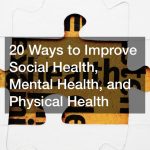In a world where wellness takes center stage, it’s no surprise that 45% of individuals are navigating the intricate path of weight loss. This journey, however, is not without its challenges. Many people push themselves to follow strict diets and intense exercise routines, which can be tough to stick to and might even cause health problems in the long run.
Therefore, it is essential to highlight the importance of healthy weight loss. Shedding weight doesn’t have to be a complicated and dangerous process. You can safely lose up to 30 pounds in a sensible time frame by following simple steps.
This guide will provide all the necessary information to get you there. Whether you’re a beginner or have been on this road before, these tips can help you achieve your desired goal.
Setting the Foundation for Success
Starting a journey to lose weight is great, but making it work well depends on how you begin. Having doable goals and knowing why you want to do this is essential. If you want to lose 30 pounds, it’s better to have smaller targets that you can reach bit by bit. This technique helps you stay focused and keeps you feeling good about your progress.
But before deciding on those goals, you need to look at yourself. What does your body need? What do you want to achieve? Understanding this area is like building a solid base for your plan. If you want more energy or just be fitter, that’s good to know. Doing so helps you stick to your plan when things get tough.
Getting advice from professionals is also a smart move. Talk to people who know about food and exercise. They can help you make a plan that fits your body and life. This way, you can be sure you’re doing things safely and getting the best results. You can connect to a medical professional or join fitness classes at your local gym, whichever suits your needs.
Look at folks who’ve already done it – like Rebel Wilson, the actress. She shared her story about losing weight. She changed how she looked and felt by having a good plan, doing exercises that worked for her, and getting help from experts. Her story shows that anyone can do it with the proper foundation and support.
Creating a Balanced and Sustainable Diet Plan
When it comes to losing weight, what you eat is essential. To keep it simple, you need to eat less than your body uses to shed those pounds. This technique is called a “calorie deficit.” But here’s the thing: while you’re eating a little less, you still need to get all the good stuff your body needs to be healthy.
To make sure you’re getting both, you need a balanced diet. Doing so ensures you eat different foods to keep your body happy. Think about including whole foods like fruits, veggies, and grains – these are the superhero foods for your body. They give you vitamins, fiber, and all kinds of good things.
Also, lean proteins are like your body’s building blocks. They help your muscles stay strong and keep you full. Another one is complex carbs, like whole grains, which give you the energy that lasts. Lastly, don’t forget that healthy fats are vital for brain health and help your body work smoothly.
Planning meals might seem tricky, but it’s pretty fun. If you’re into veggies, a vegetarian plan could be your jam. Or if you like the caveman vibe, paleo might be your thing. You can mix and match, too.
Science backs up balanced diets for weight loss. Many experts say that a diet with fewer calories but still full of good stuff is the way to go. So, a balanced diet is your best buddy if you want to lose weight.
Incorporating Physical Activity and Exercise
Physical activity is a crucial player in the game of weight loss. It revs up your metabolism, which burns more energy, including stored fat.
There are also different workouts you can try. Cardio workouts, like jogging or dancing, make your heart pump faster and get you breathing harder. Strength training is like building muscles – you can use weights or even your body weight. And then there’s HIIT, which stands for High-Intensity Interval Training. It’s similar to sprinting but in short bursts. These workouts help your body burn fat and get stronger.
But you don’t need to be in the gym every day. Even small things count, like walking your dog, dancing to your favorite tunes, or riding your bike. These daily moves add up and keep you active all the time.
Studies have shown that exercise is a real game-changer for weight loss. 90% of people who rocked their weight loss goals exercised about an hour a day, which helped them burn more calories.
Mindful Eating and Portion Control
Picture this: you’re sitting down to enjoy a delicious meal. But instead of gobbling it up like a hungry bear, you’re taking your time, savoring each bite. That’s mindful eating, a method for keeping your weight in check.
Mindful eating is about paying attention to what you eat and how you eat it. It’s like giving your food the respect it deserves. When you’re mindful, you’re less likely to scarf down heaps of food without even realizing it.
On the other hand, there is portion control. It’s all about knowing how much food your body needs. Think of it as your body’s fuel gauge – you won’t fill the tank if it’s already full, right? So, when you control your portions, you’re giving your body just what it needs, not a drop more.
A cool trick for mindful eating is to eat without distractions. Turn off the TV and put down your phone. Focus on your food – its taste, texture, and smell. Chew slowly and enjoy every bite. You’ll be surprised at how satisfying a smaller amount of food can be.
According to a study published by the University of Hampshire, mindful eating helps to lose weight and kick stress and emotional eating to the curb. Participants started listening to their bodies instead of munching away when sad or bored. They found healthier ways to cope with emotions, like walking or talking to a friend. It’s like turning a new leaf in the book of healthy habits.
Sleep and Stress Management
When it comes to losing weight, sleep, and stress are two factors that play a significant role. Think of sleep as your body’s reboot button. When you sleep well, your body repairs itself, and your metabolism stays on track. Your hormones get wonky if you’re not getting enough Zzz’s. This can mess up your appetite and make your body hold onto fat. So, aim for 7-9 hours of quality sleep each night.
Stress is like a sneaky villain that messes with your plans. When you’re stressed, your body releases a hormone called cortisol. Too much cortisol can lead to cravings for sugary, fatty foods – not exactly a friend on your weight loss journey. Plus, stress can mess up your sleep, creating a vicious cycle.
Focusing on sleep hygiene as your bedtime ritual is vital. That means keeping your room dark, avoiding screens before bed, and sticking to a sleep schedule. It helps your body know it’s time to wind down. And to reduce stress, you have plenty of options, such as deep breathing, meditation, and yoga. These activities can calm your mind and keep stress at bay.
A study once showed that sleep and stress can be significant players in weight loss. Even if people ate the same calories, those who slept less and were more stressed lost 55% less weight. It’s a reminder that sleep and stress shouldn’t be taken for granted if you want to reach your goals.
Hydration and the Importance of Staying Active
When it comes to weight loss, one thing that often gets overlooked is hydration. But it’s important for both managing your weight and overall well-being. Staying hydrated helps your body function properly and can also be a secret weapon in your journey to shed those pounds.
Proper hydration helps digestion, boosts metabolism, and keeps appetite in check. Sometimes, people mistake thirst for hunger and eat more than they need to. You can avoid this trap by staying hydrated and setting yourself up for successful weight management. This knowledge is backed by a study from John Hopkins University, which showed that drinking more water is linked to more significant weight loss.
It’s also essential to recognize the significant role that physical activity plays in the weight loss journey. Leading a sedentary lifestyle makes it harder to shed those pounds and puts your overall health at risk. Even beyond formal exercise routines, regular physical activity is crucial for boosting energy expenditure and improving metabolic function. Simple activities like walking, taking the stairs, or doing household chores add to your daily calorie burn.
You can also learn how to enjoy physical activities and make them a part of your daily routine. Choose whatever kind of exercise makes you excited, whether it’s yoga, cycling, or martial arts. Invite friends to join so that it won’t feel like a chore. Or find online videos where you can get tips on how to do the exercises correctly and safely.
Tracking Progress and Adjusting Strategies
As you tread the path toward your goal, remember that tracking your progress is like your trusty compass – it keeps you on track and guides you through the twists and turns.
Keeping track is creating a roadmap for your journey. Regular measurements and photos are like snapshots of your progress. They show you how far you’ve come and keep you motivated. Sometimes the scale might not budge, but those photos could reveal inches lost and newfound confidence gained. Remember, every step counts, even if it’s not always visible on the scale.
However, plateaus do happen, and this might feel like hitting a speed bump on the journey. When you notice progress slowing down, it’s time for you to shake things up. Maybe tweak your workouts, switch up your meals, or add a new activity. Your body is adaptable, and you can reignite your progress by switching gears.
Staying motivated during plateaus should also be on your radar. Celebrate small wins to stay focused and enjoy the journey. You can also view online stories of successful weight-loss journeys. These tales of triumph can keep you fired up and make the whole experience even more enjoyable.
Celebrating Achievements and Embracing Lifestyle Changes
Imagine your weight loss journey as a series of cool achievements and victories. When you reach a goal, like losing a certain amount of weight, it’s important to celebrate and feel proud. These happy moments are signs that you’re on the right track.
But weight loss isn’t just about hitting a target and then stopping. It’s more of a journey to improve your whole lifestyle. Instead of just aiming for a short-term goal, you’re making remarkable changes that will stick around for the long run.
As you transform, you’ll learn how to eat better with tasty and healthy foods, stay active, and pay attention to how you feel when you eat. These new habits become part of your everyday life, making you feel incredible.
When it comes to keeping up your success, having a secret weapon is essential. You must keep eating good stuff, staying active, and making smart choices. Doing so helps you avoid returning to old habits and feeling like you’re taking steps backward.
Some people have already rocked this journey and made tremendous life changes. They didn’t just lose weight – they embraced a new way of living. By making healthier choices and staying active, they became healthier and happier. These inspiring stories are proof that you can do it, too.
These strategies are essential to consider when it comes to losing 30 pounds. As you embark on your weight loss journey, prioritize your well-being and embrace the transformative power of a healthier lifestyle. Remember, your journey is unique – so nurture it, stay determined, and watch yourself thrive! By taking care of your body, you will be surprised at the changes that come with it – inside and out.


